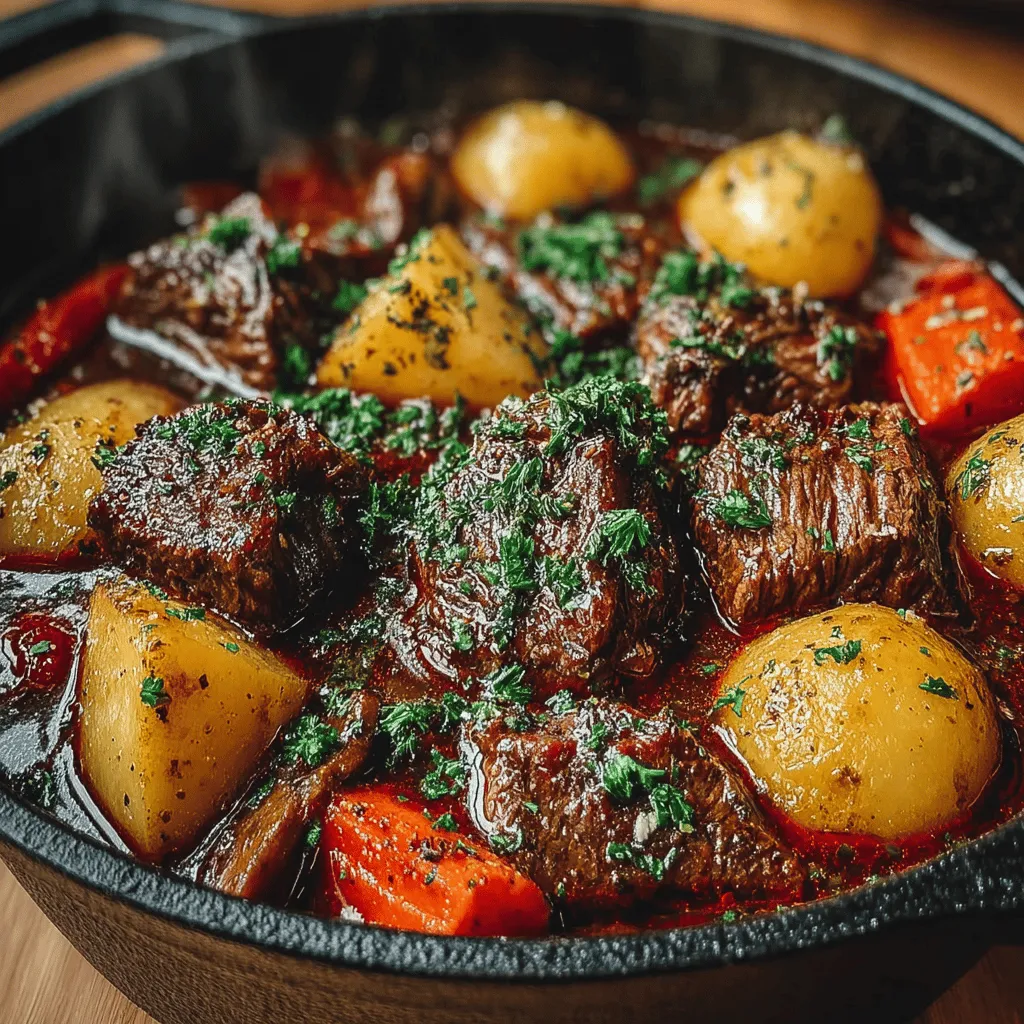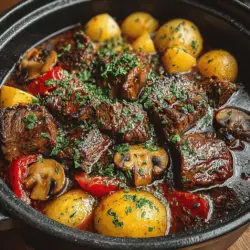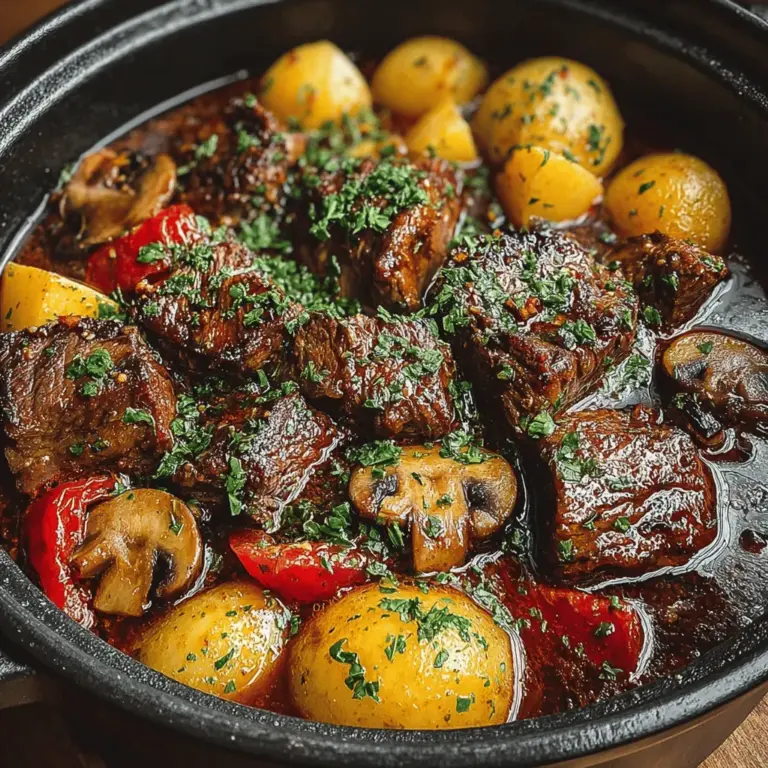Rustic Red Wine Beef Stew: A Hearty Comfort Food Classic
When the temperatures drop and the days grow shorter, few dishes provide the warmth and comfort of a well-made beef stew. Rustic Red Wine Beef Stew is not just a meal; it is a culinary hug in a bowl, rich in flavor and steeped in tradition. This dish has graced tables for generations, originating from rustic kitchens where hearty meals were crafted to nourish families and bring them together. The combination of tender beef, savory vegetables, and aromatic herbs creates a symphony of flavors that is not only satisfying but also deeply comforting.
In this recipe, we celebrate the art of slow cooking, where time allows the ingredients to meld beautifully, resulting in a rich and robust stew. The star of this dish is undoubtedly the beef, which becomes meltingly tender as it simmers in a rich broth infused with red wine. The depth of flavor achieved through this process elevates the dish beyond typical comfort food, making it a memorable centerpiece for family dinners or gatherings with friends.
Flavor Profile and Ideal Occasions
What makes Rustic Red Wine Beef Stew truly special is its complex flavor profile. The deep, savory notes of the beef are complemented perfectly by the acidity and fruitiness of the red wine, while the vegetables add both sweetness and earthiness. Each spoonful offers a balance of richness and freshness, a hallmark of excellent stews. This dish is ideal for various occasions—whether it’s a cozy family dinner on a chilly evening, a gathering during the holidays, or simply a comforting meal to enjoy after a long day. Pair it with crusty bread or buttery mashed potatoes, and you have a complete meal that warms both body and soul.
Understanding the Ingredients
To create the perfect Rustic Red Wine Beef Stew, it’s crucial to understand the key ingredients that contribute to its flavor and texture. Each component plays a vital role, ensuring that the final dish is not only delicious but also well-balanced.
Beef Chuck: The Best Cut for Stews
When it comes to beef for stews, beef chuck is the go-to cut. This cut comes from the shoulder area of the cow and is known for its rich marbling and connective tissues, which break down beautifully during the slow cooking process. The result is tender, flavorful chunks of meat that absorb the surrounding flavors. Selecting high-quality beef is essential; look for cuts that are well-marbled with a good amount of fat, as this will enhance the overall taste and texture of the stew.
Red Wine: Importance of Wine Selection
The choice of red wine is critical in this recipe. While many options exist, two popular choices are Merlot and Cabernet Sauvignon. Merlot tends to be softer and fruitier, which can add a hint of sweetness to the stew, while Cabernet Sauvignon offers bolder tannins and a more robust flavor profile. Ultimately, the best wine for your stew will depend on your personal preference, but avoid using anything labeled as “cooking wine,” as it often contains added salt and preservatives that can detract from the dish’s overall quality. Instead, opt for a wine that you would enjoy drinking, as it will enhance the flavor of the stew.
Vegetables: Building Blocks of Flavor and Texture
The vegetables in this stew play a crucial role in adding depth and complexity. Onions provide a sweet and savory base, while carrots contribute a natural sweetness and vibrant color. Potatoes not only add heartiness but also help to thicken the stew as they cook down. Lastly, mushrooms lend an earthy flavor that complements the beef and wine beautifully. Choosing fresh, high-quality vegetables will elevate your dish; consider using a mix of different potato varieties or adding parsnips for an extra layer of flavor.
Herbs and Seasonings: Enhancing the Dish
No stew is complete without the right blend of herbs and seasonings. Thyme, rosemary, and bay leaf are classic choices that infuse the dish with aromatic flavors. Thyme offers a subtle earthiness, while rosemary adds a warm, piney note. Bay leaves contribute a complex depth that enhances the overall flavor profile. Be sure to remove the bay leaves before serving, as they can be tough and unpalatable if consumed.
Preparation Steps Explained
Now that we have an understanding of the key ingredients, let’s delve into the preparation steps necessary to create this Rustic Red Wine Beef Stew. Each step is designed to maximize flavor and ensure that every component contributes to the final dish.
Browning the Beef: The Maillard Reaction
The first step in preparing your stew is to brown the beef chuck. This is a crucial technique known as the Maillard reaction, where the natural sugars and proteins in the meat react to heat, creating a rich, brown crust that enhances the overall flavor of the stew. To achieve this, heat a heavy-bottomed pot or Dutch oven over medium-high heat and add a bit of oil. Once the oil is hot, add the beef in batches, ensuring not to overcrowd the pot. Allow the meat to sear on all sides until a deep brown color forms, about 4-5 minutes per side. This step not only adds flavor but also creates fond, the brown bits stuck to the bottom of the pot, which will be deglazed later.
Sautéing Aromatics: Building the Base Flavor
After browning the beef, it’s time to build the base flavor of your stew by sautéing the aromatics. In the same pot, add diced onions and minced garlic, scraping the bottom to release the fond. The onions will begin to caramelize, adding sweetness and depth, while the garlic will infuse the dish with its fragrant aroma. Sauté these aromatics for about 3-4 minutes, or until the onions are translucent and fragrant, stirring occasionally to ensure even cooking.
Adding Vegetables: Timing and Technique
Once the onions and garlic are beautifully sautéed, it’s time to add the remaining vegetables. Start with the carrots and potatoes, as they require a longer cooking time to become tender. Stir them into the pot and let them cook for a few minutes, allowing them to absorb the flavors of the aromatics. After a few minutes, add the mushrooms, which will release moisture and further enhance the stew’s richness. The order of adding vegetables is important; by introducing them in stages, you can ensure that each component reaches the perfect texture.
Deglazing: Scraping the Pot for Maximum Flavor
With the vegetables added, it’s now time to deglaze the pot. Pour in your selected red wine, scraping the bottom of the pot with a wooden spoon to lift the flavorful bits left behind from browning the beef and sautéing the vegetables. This step is essential, as it incorporates those concentrated flavors into the stew and adds acidity from the wine, which helps to tenderize the meat further.
Combining Ingredients: The Right Order for Optimal Cooking
After deglazing, return the browned beef to the pot, along with any juices it may have released. Next, add beef broth or stock, ensuring the ingredients are just covered. This liquid will serve as the stew’s base, allowing the flavors to meld beautifully as it cooks. Finally, toss in your herbs—thyme, rosemary, and bay leaf—and season generously with salt and pepper. Stir everything together, ensuring an even distribution of ingredients.
Slow Cooking: Low and Slow for Tenderness
The final step in preparing your Rustic Red Wine Beef Stew is to allow it to cook slowly. Bring the mixture to a gentle simmer, then cover the pot and reduce the heat to low. This low-and-slow cooking method is essential for breaking down the tough fibers in the beef, resulting in a tender and flavorful stew. Depending on your schedule, you can let it simmer on the stovetop for about 2-3 hours or transfer it to a preheated oven set at 325°F (160°C) for a similar cooking time. The longer you allow the stew to cook, the more the flavors will develop, creating a rich and hearty dish that is sure to impress.
As you embark on the journey of creating Rustic Red Wine Beef Stew, remember that the process is just as important as the final result. Each step builds upon the last, culminating in a dish that is not only delicious but also a testament to the beauty of home-cooked meals. Stay tuned for the next part of this article, where we will explore additional cooking techniques and tips to perfect your stew.

Importance of Using a Dutch Oven or Heavy Pot
When it comes to crafting the perfect beef stew, the choice of cooking vessel is crucial. A Dutch oven or a heavy pot is highly recommended for several reasons. First and foremost, these types of cookware provide even heat distribution, which is essential for slow cooking. This ensures that the beef and vegetables cook consistently throughout, preventing any overcooked or undercooked pieces in your stew.
The thick walls of a Dutch oven help retain heat, allowing for gentle simmering. Unlike thinner pots, which may cause hot spots and lead to uneven cooking, a Dutch oven maintains a steady temperature, essential for developing the stew’s rich flavors. Moreover, the lid traps steam, keeping the moisture locked in, which is vital for a tender and juicy outcome.
Simmering vs. Boiling: Achieving the Perfect Stew Consistency
Understanding the difference between simmering and boiling is key to perfecting your stew. Boiling is characterized by large bubbles rapidly breaking the surface of the liquid, which can lead to tough meat and mushy vegetables. Simmering, on the other hand, is a gentle cooking method where small bubbles rise slowly to the surface. This technique allows the flavors to meld beautifully without compromising the texture of the ingredients.
To achieve the perfect stew consistency, bring your stew to a boil initially to get it hot, then reduce the heat to a low setting, allowing it to simmer. A good rule of thumb is to aim for a temperature around 185°F to 205°F (85°C to 96°C). This will help tenderize the beef while allowing the vegetables to soften without disintegrating. Keep an eye on the pot, occasionally stirring to ensure nothing sticks to the bottom, and adjust the heat as necessary.
Adjusting Seasoning: Tasting and Modifying Flavors During Cooking
As you cook your Rustic Red Wine Beef Stew, it’s essential to taste and adjust the seasoning throughout the process. Start by seasoning the beef before browning it in the Dutch oven. This initial seasoning lays the groundwork for flavor development. However, as the stew cooks, you may find that it needs a little more salt, pepper, or even a splash of additional red wine to enhance its depth.
Adding herbs like thyme, bay leaves, or rosemary can also elevate the flavor profile. Be sure to taste the stew periodically, especially in the last half hour of cooking. This is when flavors concentrate, and you might need to balance the richness with acidity. A dash of vinegar or a squeeze of lemon can brighten the dish and make the flavors pop.
Serving Suggestions
Ideal Side Dishes
To complement the heartiness of your Rustic Red Wine Beef Stew, consider serving it with ideal side dishes that enhance the meal experience. Crusty bread is a classic accompaniment, perfect for soaking up the rich sauce. A fresh green salad with a light vinaigrette can provide a refreshing contrast to the stew’s warmth and depth.
For a more substantial pairing, creamy mashed potatoes or buttery polenta make excellent bases for the stew, allowing you to enjoy every last bit of sauce. Alternatively, roasted vegetables could add a delightful crunch and additional nutrients to your meal.
Presentation Tips
Presentation is key to making your beef stew not just a meal, but an experience. Serve the stew in rustic bowls to enhance its charm. Garnish with freshly chopped parsley or thyme for a pop of color. Consider a drizzle of extra virgin olive oil or a sprinkle of freshly cracked black pepper just before serving, as this adds a finishing touch and heightens the aroma of the dish.
Suggested Beverage Pairings
Pair your stew with the same red wine used in the cooking process for a harmonious dining experience. A full-bodied red wine, such as Cabernet Sauvignon or Merlot, enhances the flavors of the dish beautifully. If you prefer something non-alcoholic, consider serving a sparkling water with a wedge of lemon or a herbal iced tea to cleanse the palate.
Nutritional Aspects
Overview of Nutritional Benefits
The ingredients in your Rustic Red Wine Beef Stew contribute not only to its rich flavor but also to its nutritional profile. Beef is an excellent source of protein, essential for muscle repair and overall health. It also contains important vitamins and minerals such as iron, zinc, and B vitamins, all of which support various bodily functions.
Nutritional Value of Vegetables
The vegetables in the stew, including carrots, onions, and potatoes, provide a range of nutrients and dietary fiber. Carrots are rich in beta-carotene, which is beneficial for eye health, while potatoes are a great source of potassium and vitamin C. Onions add flavor and antioxidants, making them an essential ingredient both for taste and nutrition.
Caloric Considerations
While a hearty beef stew can be indulgent, it can also be part of a balanced diet. The caloric content will depend on the specific ingredients and portion sizes, but a typical serving of beef stew provides a satisfying meal that can be enjoyed without guilt. Remember, moderation is key, and pairing your stew with lighter sides can help balance the overall calorie intake.
Balance of Indulgence and Health
Home cooking allows for the flexibility to create meals that are both indulgent and nutritious. By incorporating quality ingredients and balancing flavors, you can create a dish that satisfies cravings while providing nourishment. The Rustic Red Wine Beef Stew captures this balance perfectly, offering comfort food without sacrificing health.
Storing and Reheating Leftovers
Best Practices for Storing Beef Stew
After enjoying your Rustic Red Wine Beef Stew, you may find yourself with delicious leftovers. Proper storage is essential to maintain flavor and quality. Allow the stew to cool completely before transferring it to an airtight container. Refrigerate leftovers within two hours of cooking to ensure food safety. The stew can be stored in the refrigerator for up to three days.
If you wish to keep it longer, consider freezing the stew. Portion it into freezer-safe containers, leaving some space for expansion. Frozen beef stew can last for up to three months and can be a lifesaver on busy weeknights.
How to Reheat for Optimal Flavor and Texture Preservation
When it’s time to enjoy your leftovers, reheating them correctly is crucial to preserving flavor and texture. For best results, reheat the stew gently on the stovetop over low heat, stirring occasionally. If the stew seems too thick, add a splash of beef broth or water to achieve your desired consistency.
Microwaving is a quick alternative but can lead to uneven heating. If you choose this method, cover the bowl with a microwave-safe lid or wrap to retain moisture and heat in short bursts, stirring in between.
Suggested Ways to Repurpose Leftovers
Leftovers from your Rustic Red Wine Beef Stew can be repurposed creatively. One popular option is to use the stew as a filling for a pot pie. Simply pour the stew into a pie crust, top it with another layer of pastry, and bake until golden brown. You can also transform the stew into a hearty pasta sauce, simply by tossing it with your favorite cooked pasta for a delightful meal.
Conclusion
The Rustic Red Wine Beef Stew is more than just a meal; it embodies the warmth and comfort of home-cooked food. With its rich flavors and hearty ingredients, this stew is perfect for sharing with loved ones on a chilly evening. The process of creating this dish—from selecting quality ingredients to savoring the final product—offers a rewarding cooking experience that anyone can appreciate.
As you gather around the table with family or friends, take a moment to relish the joy of cooking and the shared experience that comes with enjoying a hearty stew. We encourage you to try this recipe, allowing the rich flavors and comforting nature of the Rustic Red Wine Beef Stew to envelop you in warmth and satisfaction. Embrace the rustic charm of this dish, and let it become a beloved staple in your home cooking repertoire.

